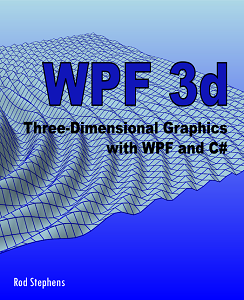Title: Pingback: Code Project post "Orbital Mechanics Introduction, Part 2"
![[Pingback: Code Project post 'Orbital Mechanics Introduction, Part 2']](code_project_orbital_mechanics.png)
The Code Project post Orbital Mechanics Introduction, Part 2 by charles922 uses some code from my WPF 3D posts. His program lets you experiment with the following orbital parameters:

- Eccentricity - the eccentricity of the orbit's ellipse.
- Inclination - the vertical tilt of the ellipse with respect to the orbital plane measured at the ascending node (where the orbit passes upward through the orbital plane).
- Semi-major Axis - the semi-major axis of the orbit's ellipse.
- Longitude of the Ascending Node (Omega, ?) - horizontally orients the ascending node of the ellipse.
- Argument or Periapsis - defines the orientation of the ellipse in the orbital plane, as an angle measured from the ascending node to the periapsis.
To see Charles' post, click here.
For LOTS more information on three-dimensional graphics in WPF, see my book WPF 3d, Three-Dimensional Graphics with WPF and C#.
|
![[C# Helper]](../banner260x75.png)

![[Beginning Database Design Solutions, Second Edition]](db2_79x100.png)
![[Pingback: Code Project post 'Orbital Mechanics Introduction, Part 2']](code_project_orbital_mechanics.png)
![[Beginning Software Engineering, Second Edition]](book_sw_eng2_79x100.png)
![[Essential Algorithms, Second Edition]](book_algs2e_79x100.png)
![[The Modern C# Challenge]](book_csharp_challenge_80x100.jpg)
![[WPF 3d, Three-Dimensional Graphics with WPF and C#]](book_wpf3d_80x100.png)
![[The C# Helper Top 100]](book_top100_80x100.png)
![[Interview Puzzles Dissected]](book_interview_puzzles_80x100.png)
![[C# 24-Hour Trainer]](book_csharp24hr_2e_79x100.jpg)
![[C# 5.0 Programmer's Reference]](book_csharp_prog_ref_80x100.png)
![[MCSD Certification Toolkit (Exam 70-483): Programming in C#]](book_c_cert_80x100.jpg)
